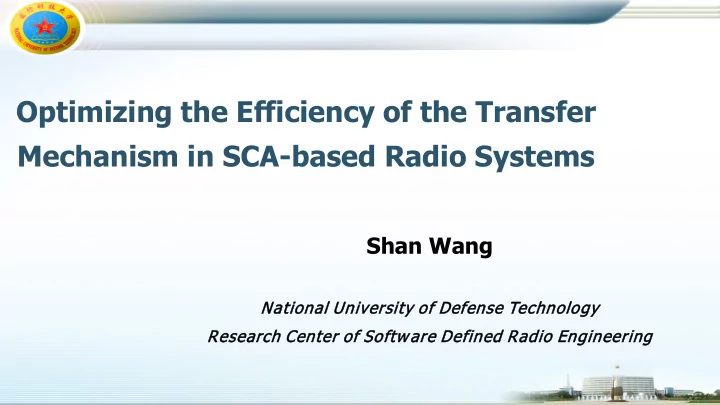

Optimizing the Efficiency of the Transfer Mechanism in SCA-based Radio Systems Shan Wang National University of Defense Tech chnology Research ch Center of Softw are Defined Radio Engineering
Outline Problem of CORBA ( Linux-kernel-based ) Analysis of Causes Optimization Proposal Adoption and Proven
Some Premises In SCA 4.1 specifications, the transfer mechanism becomes more flexible and diversified. As a classical transfer mechanism, CORBA has been widely used in SCA-based software radio systems. Communication between components can be classified by their locations : inter-chip and intra-chip, we call them remote-call and local-call separately.
Problem of CORBA Delay ( μs ) Application Environment 1200 ARM Cortex-A7 971 968.6 967.7 965.84 ( Zynq70xx ) 961.9 960.6 1000 Linux-3.17 800 TAO 600 1GB RAM omniORB 400 CF-SCA4.1 173.3 175.2 173.6 173.8 173.3 173.8 200 TAO & omniORB 0 1 2 3 4 5 Avg
Problem of CORBA Delay ( μs ) Application Environment 300 276 272.2 270.2 267.9 265.3 Intel i7-6700 255.8 250 Linux Ubuntu14.02 200 TAO 150 4GB RAM omniORB 100 CF-SCA4.1 44.2 44.3 43.4 43.1 43.26 41.3 50 TAO & omniORB 0 1 2 3 4 5 Avg
Results show that the efficiency of the ORB-based middleware, such as TAO and omniORB, has become one of the challenges that constrain SCA to be Why? further widely applied.
In many Linux based applications, Core Framework starts all components in process mode, including device/service components, and waveform components. The advantage is that it loosens the difference of program languages and can work in distributed networks. However, the disadvantage is also obvious, especially in what we call the intra-chip application environment.
Local-call Characteristics How to integrate process mode with thread mode flexibly. Thread Mode
Domain Manager Device Manager Device GPP Device, FPGA Device, DSP Device, Ethernet Device, Application Serial Device, Platform NET Component, LLC Service, etc. Component, Security Component, etc.
TAO’s Delay (μs ) omniORB’s Delay ( μs ) Application Environment 300 50 276 272.2 126 times 196 times 270.2 267.9 44.3 265.3 44.2 43.4 43.26 43.1 255.8 45 41.3 Intel i7-6700 250 40 35 Linux Ubuntu14.02 200 30 4GB RAM Process Mode Process Mode 25 150 Thread Mode Thread Mode 20 CF-SCA4.1 100 15 10 Process VS. Thread 50 5 0.3 0.22 0.2 0.2 0.2 0.2 2.3 2.1 2.1 2 2.1 2.12 0 0 1 2 3 4 5 Avg. 1 2 3 4 5 Avg.
TAO’s Delay (μs ) omniORB’s Delay ( μs ) Application Environment 26 times 29 times 1200 200 175.2 173.6 173.8 173.8 173.3 173.3 180 968.6 ARM Cortex-A7 971 967.7 965.84 961.9 960.6 1000 160 140 Linux-3.17 800 120 1GB RAM Process Mode Process Mode 600 100 Thread Mode Thread Mode 80 CF-SCA4.1 400 60 40 Process VS. Thread 200 20 36.1 36.3 36 37.2 37.3 36.56 5.9 6.1 6.01 6.03 6.05 6.02 0 0 1 2 3 4 5 Avg. 1 2 3 4 5 Avg.
Process Mode This mode is suitable for waveform resource deployment based on multi - channel equipment or control interactions among different nodes. Thread Mode Components must run in the same program space. So, it is suitable for small size SoC system or waveform applications located in the same processor.
Thank you. Any question ?
Recommend
More recommend